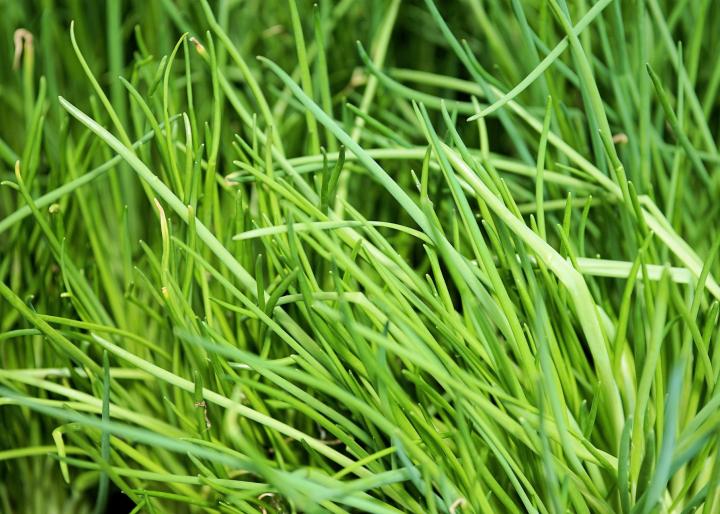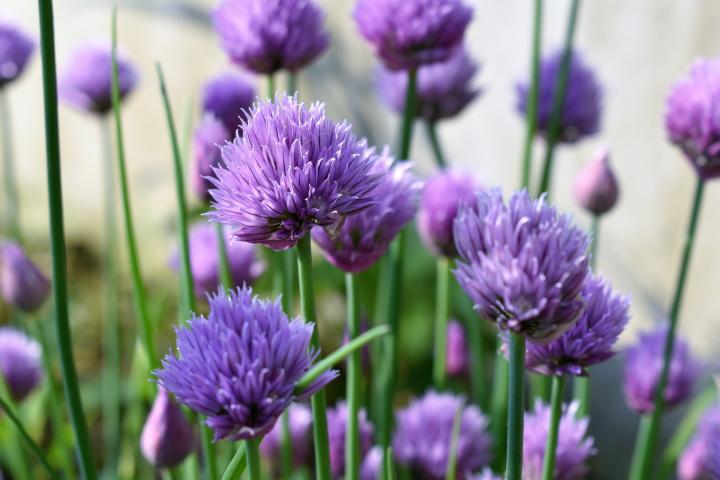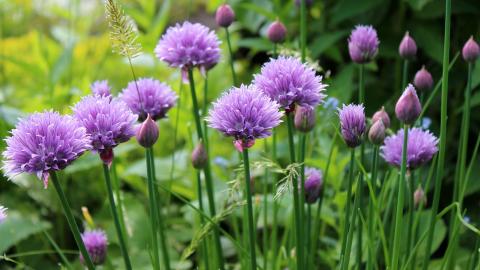Chives are a perennial member of the onion family that sport beautiful edible flowers. Plus, they’re a wonderful companion plant that helps deter pests. Here’s how to grow chives in your garden!
Chives are cool-season, cold-tolerant perennials that are best planted in early to mid-spring for an early summer harvest.
Be mindful when planting this herb, as it will take over your garden if the flowers are allowed to develop fully (the flowers scatter the seeds). However, this plant is easy to dig up and move if it does end up invading other parts of your garden.
Chives are also a wonderful companion plant that deters pests. They’re a good friend to plant with carrots, celery, lettuce, peas, and tomatoes.
Types of Chives to Grow
The two species of chives commonly grown in home gardens are common chives (Allium schoenoprasum) and garlic chives (A. tuberosum):
- Common chives consist of clumps of small, slender bulbs that produce thin, tubular, blue-green leaves reaching 10-15 inches in height. The edible, flavorful flowers may be white, pink, purple, or red, depending on variety. They can be grown in zones 3 to 9.
- Garlic chives (also called Chinese chives) look similar to common chives, but their leaves are flatter, greener, and get to be about 20 inches in height. As their name suggests, their leaves have a mild garlic flavor (bulbs are more intense). Flowers are white, and are larger and less densely-clustered than those of common chives. Garlic chives are not quite as cold hardy as common chives, so they are recommended for zones 4 to 9.
When to Plant Chives
- Chives are considered a cool-season crop, which means that they grow best in the spring and fall. The harsher temperatures of summer usually cause them to go dormant until cool weather arrives again.
- For a head start in colder regions, start chive seeds indoors 6 to 8 weeks before the last spring frost. (See local frost dates.) Transplants need good growth before being set in the garden.
- Outdoors, sow seeds as soon as the soil is workable in the spring. Note that they can take a few weeks to germinate, so don’t panic! For the best germination and growth, the temperature of the soil should be between 60º and 70ºF (15º and 21ºC).
- Plant transplants outdoors once the threat of frost has passed.
Choosing and Preparing the Planting Site
- Chives grow best in full sun, though they will tolerate light shade.
- Soil needs to be moist, fertile, rich, and well-draining. Before planting, incorporate 4 to 6 inches of well-composted organic matter. Work compost into the soil to a depth of 6 to 8 inches. (Read more about soil amendments and preparing soil for planting.)
How to Plant Chives
- Sow seeds about 2 inches apart and no more than ¼ inch deep. Cover with a thin layer of soil.
- Once seedlings emerge, thin so that plants are spaced between 4 to 6 inches apart in all directions.

How to Grow Chives
- Minimal care is needed for fully-grown, established plants.
- Although chives are drought tolerant, it’s important to give them consistent watering throughout the growing season for high yields. Moisten the soil thoroughly when watering.
- Chives’ small bulbs grow near the soil surface, so use mulch to conserve moisture and keep the weeds down.
- For good production, top-dress with a nitrogen-heavy fertilizer in late spring or early summer if your soil is not already nutrient-rich.
- After the flowers bloom, be sure to remove them so that the seeds aren’t spread throughout your garden.
- Remember to divide the plants every 3 to 4 years in the spring. Chives are much more productive if divided regularly. Divide them into clumps of at least 10 small bulbs and allow divided plants to grow for several weeks before harvesting.
- Bulb rots (caused by soilborne fungi)
- White rot
- Mildew
- Rust
- Smut
- Fungal leaf spots (such as purple blotch and gray mold)
- Onion fly
- Thrips
- Garlic chives, to add a mild garlic flavor to any dish
How to Harvest Chives
- Begin harvesting chive leaves about 30 days after you transplant or 60 days after seeding.
- Be sure to cut the leaves down to the base when harvesting (within 1 to 2 inches of the soil).
- Harvest 3 to 4 times during the first year. In subsequent years, cut plants back monthly.
- The chive plant will flower in late spring or early summer. The flowers are edible and taste best just after they have opened—they should look full and bright.

How to Store Chives
- Use chives when they’re fresh or frozen (freeze the leaves in an airtight bag). Dried chives lose their flavor.
- Store chives in a cool place in a resealable container.
- In the garden, plant chives next to carrots and tomatoes, but avoid planting near beans and peas.
- Chives are said to repel aphids and Japanese beetles. Plant them near susceptible plants.
- Bunches of chives hung in the home were used to drive away diseases and evil. Find out more herbal folklore here.
- Chives are said to symbolize usefulness. Find out more plant symbolism here.




